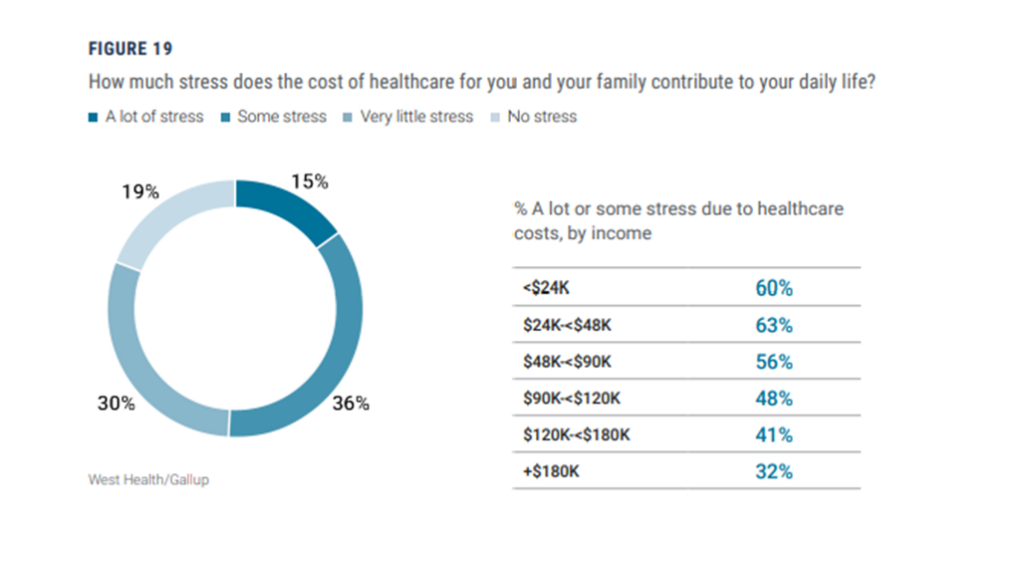
Are Out-of-Pocket Costs A Barrier to Care?
Consumer out-of-pocket spending on healthcare was projected to hit almost $500 billion in 2021 – and is expected to reach nearly $800 billion in 2026, according to healthcare market research group Kalorama Information. “Salary growth will continue to lag healthcare cost increases and as consumers are unable to afford rising expenditures, they will increasingly forgo treatment and/or search for less expensive options such as generic or OTC medications,” Kalorama wrote in a release.
A new survey from Gallup and West Health finds that about a third of Americans say they’ve skipped medical care that they needed in the past three months due to concerns about the cost. With such concerning studies coming out, now is the time for employers to be thinking about their upcoming benefits strategy and how to help their employees manage out-of-pocket spending.
Encourage Preventive Care
Under the Affordable Care Act, private health plans must provide coverage for a range of preventive services and may not impose cost-sharing (such as co-payments, deductibles, or co-insurance) on patients receiving these services. But just covering them isn’t enough. Employers should think about how best to encourage the use of these services. Is an on-site or near-site clinic available to employees to make it more accessible? Do employees have to use vacation time they might not want to use in order to go to the doctor? If so, consider providing specific time off, or sick time, for doctor and dentist visits to encourage preventive care. All of this care has no out-of-pocket cost and can help to head off more significant problems that may arise.
Fund HSA Accounts Upfront
For employees with an HSA, fund accounts in advance so that employees can use the HSA for out-of-pocket costs early in the coverage cycle. It would make it more likely that employees will receive needed care early in the year before they meet their deductible and out-of-pocket limits. This can help reduce employee concerns over out-of-pocket healthcare costs. Consider tying those funds to a Health Risk Assessment or something similar to encourage employee yearly check-ins on their health.
Consider Steering and Tiering
While steering employees to certain doctors and hospitals may not seem like an employer’s place, this can help save the employee – and the health plan – a considerable amount of money. Encouraging employees to go where care is good and costs are low is key. The Alliance can provide data on which hospitals and providers employers might want to recommend to employees. We even have a tool called Smarter Care AdvisorSM that employees can use when making decisions about their care. And if they’re concerned about the price of care, The Alliance offers a Cost Estimate Request Form so employees can get a better idea of the costs and plan for them accordingly.
But if you’re really looking to help employees avoid out-of-pocket costs, employers can also tier their benefit design and recommend providers with no out-of-pocket costs. While that may have employers scratching their heads on how they can afford that, the savings can be significant if the right hospitals and providers are chosen. Passing these savings along to employees could be a goodwill gesture that is appreciated in these uncertain economic times.
Customize Benefits
The burden of healthcare costs doesn’t just affect your employees’ wallets. More than half of Americans report that the cost of healthcare contributes some or a lot of stress to their daily life. The chance of experiencing stress rises steadily among those with lower household incomes.

Some employers are even changing their benefit plan design to ensure that the cost-sharing for lower-income workers is manageable to ensure they can get the care they need.
Provide Out-of-Pocket Examples and Education
People are confused about deductibles, co-payments, maximum out-of-pocket costs, and other terms. Give employees examples of out-of-pocket costs for common procedures to help employees more accurately envision the actual costs they need to plan for financially. These examples should include routine, preventive care that is typically fully covered, and examples that may vary based on whether the employee has met their maximum out-of-pocket costs. Ongoing educational sessions and planning tools offered in the workplace may also help employees plan for out-of-pocket costs over the course of the year, not just at open enrollment periods.
Consider providing financial planning support to help people understand how to meet their deductible. Discuss automatic withdrawals from their paychecks to be deposited into their HSA and the amount needed to hit the deductible. And how important emergency savings can be. An estimated 41% of adults face healthcare debt, ranging from under $500 (16%) to $10,000 or more (12%), according to a 2022 Kaiser Family Foundation report. Help your employees avoid it.
Consult with The Alliance
If you are a client of The Alliance and would like to discuss your data, educational materials available to assist your employees, or recommendations on benefit plan design, please reach out to your Account Executive. They would be happy to consult with you. We want to help you so that you can help your employees.








